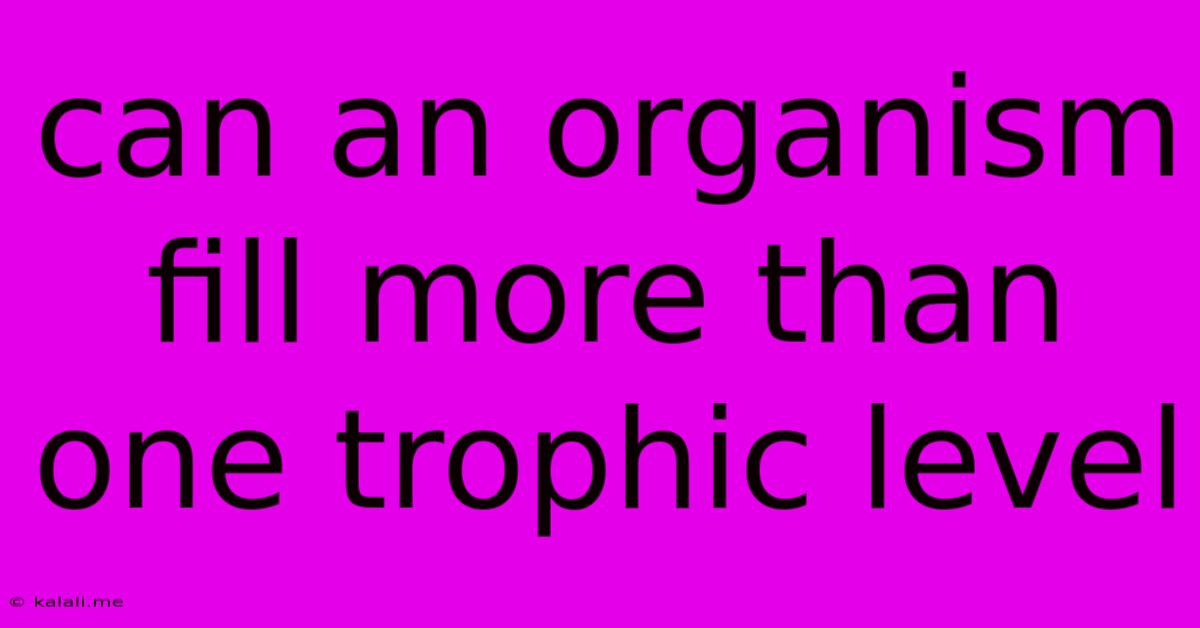Can An Organism Fill More Than One Trophic Level
Kalali
May 08, 2025 · 3 min read

Table of Contents
Can an Organism Fill More Than One Trophic Level? A Look at Ecological Complexity
Meta Description: Explore the fascinating world of trophic levels and discover how some organisms defy simple categorization by occupying multiple positions in the food web. Learn about omnivores, apex predators, and the nuances of ecological roles.
Organisms are rarely confined to a single, neatly defined role within an ecosystem. While the simplified textbook diagrams depict clear-cut trophic levels – producers, primary consumers, secondary consumers, and so on – the reality is far more nuanced and complex. The question of whether an organism can fill more than one trophic level is not a simple yes or no; the answer lies in understanding the intricate relationships and dietary habits within a food web.
Understanding Trophic Levels
Before delving into the complexities, let's briefly review trophic levels. These levels represent the position an organism occupies in a food chain, indicating its feeding relationships. Producers, such as plants and algae, form the base, converting sunlight into energy. Primary consumers feed on producers (herbivores), secondary consumers feed on primary consumers (carnivores), and so forth. Apex predators are at the top of the food chain, with few or no natural predators. Decomposers, like bacteria and fungi, break down organic matter, recycling nutrients back into the ecosystem.
The Omnivore's Paradox: A Multi-Level Eater
One clear example of organisms occupying multiple trophic levels is omnivores. These animals consume both plants and animals. A bear, for instance, might feed on berries (primary consumer) and salmon (secondary or tertiary consumer), effectively occupying at least two trophic levels. Similarly, humans, with their diverse diets, are quintessential examples of multi-level consumers. Our consumption of plants, animals, and even other processed foods places us in various positions along the food web.
Apex Predators and Dietary Flexibility
Even apex predators, often depicted as solely occupying the highest trophic level, can exhibit dietary flexibility that blurs the lines. A lion, typically considered a top predator, may occasionally scavenge, consuming carcasses left behind by other animals. This scavenging behavior technically places them in a lower trophic level, at least temporarily. Such adaptability demonstrates the dynamism inherent in ecological roles.
The Importance of Considering the Entire Food Web
The concept of trophic levels is a useful simplification, but it's crucial to remember it’s just a model. The real-world ecological interactions are far more intricate, represented by complex food webs. A single organism's position isn't static; it can shift depending on food availability and other environmental factors. Therefore, instead of focusing solely on assigning organisms to specific levels, a more holistic understanding of their role within the entire food web provides a more accurate picture.
The Influence of Seasonal Changes and Resource Availability
The trophic level an organism occupies can even vary throughout its lifespan or across seasons. A young animal might primarily be a herbivore, transitioning to a carnivorous diet as it matures. Similarly, resource availability can significantly influence an organism's feeding habits. If a preferred prey source becomes scarce, an animal might shift its diet, occupying a different trophic level until resources rebound.
Conclusion: Beyond Simple Categorization
In conclusion, the simplistic notion of a single trophic level for each organism often falls short of capturing the richness and complexity of ecological interactions. Many organisms, particularly omnivores, occupy multiple trophic levels throughout their lives, highlighting the dynamic nature of food webs and the fluidity of ecological roles. Understanding this complexity is crucial for a more comprehensive understanding of ecosystem functioning and conservation efforts.
Latest Posts
Latest Posts
-
How Much Is 20 Of 300
May 09, 2025
-
Living And Nonliving Things In An Ecosystem
May 09, 2025
-
What Is 60 Out Of 100
May 09, 2025
-
36 Is 15 Of What Number
May 09, 2025
-
What Is 0 09 As A Fraction
May 09, 2025
Related Post
Thank you for visiting our website which covers about Can An Organism Fill More Than One Trophic Level . We hope the information provided has been useful to you. Feel free to contact us if you have any questions or need further assistance. See you next time and don't miss to bookmark.